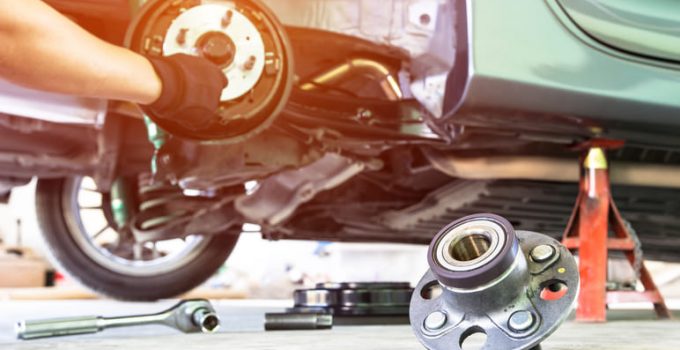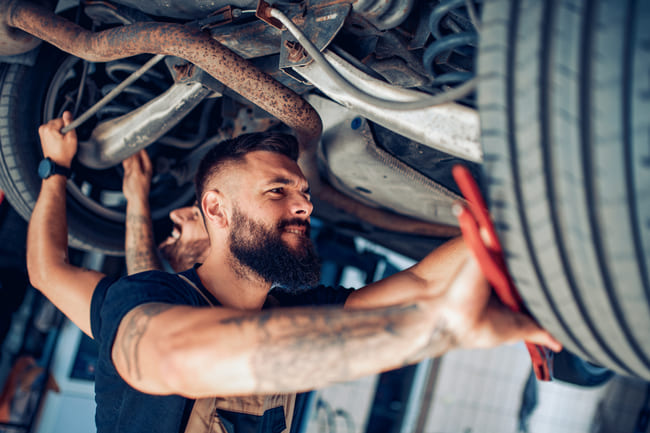
The purpose of your wheel bearings is to keep your wheels rotating with the axle connect to. These vehicle parts are particularly stressed in tight bends or when parking on the sidewalk. Therefore, older vehicles in particular tend to have broken wheel bearings. The wheel bearings often generate noise and you have the feeling that your car is booming when driving. Below we give you the information you need to diagnose your wheel bearings.
Contents
A wheel bearing is defective – what can happen?
Most drivers think that if there is a small defect in the wheel bearing and the noise that goes with it, little or nothing can happen. However, this is not true, because a squeaking wheel bearing is already an alarm sign of a safety-relevant vehicle part.
At the beginning of a wheel bearing defect, there is usually the corresponding noise development. In particular, you can observe that the background noise continues to deteriorate over time. You can recognize an impending failure by louder noises when you drive faster or when you are driving on winding routes. The resulting vibrations of your car often create a certain amount of insecurity, so that the driver often drives much more unsafe than usual.

After all, the ultimate consequence of a wheel bearing failure is that it completely locks up or overheats, preventing your wheel from turning at all. Since this can happen regardless of speed, you can then no longer avoid oncoming vehicles or cornering becomes a gamble. Increased wheel bearing play can also cause your car to respond less precisely to steering movements.
This also poses a significant risk that you could lose control of the vehicle.
We recognize that your wheel bearings are defective?
In principle, there are two important facts that indicate a wheel bearing defect. These primarily include specific noises and unusual jerking during your journey.
The noise from your wheel bearings is generally loudest when cornering. It is usually about grinding or clicking noises. Many drivers also notice a corresponding hum. The noises arise in particular when cornering on one side of the vehicle. These symptoms of a wheel bearing defect are dependent on wear and tear. Conversely, this means that the background noise is getting louder and louder, so that you can also hear noises when driving straight ahead. In many cases you can notice this deterioration after just a few hundred kilometres. So hurry up and do it yourself or hire a specialist you trust.

Shaking of your steering wheel could also indicate a wheel bearing defect. If you recognize such problems with your steering, we recommend that you drive directly to your specialist workshop. Also in this subject area is jerking when driving in general. This is formed when your vehicle shakes on the road surface. Basically, of course, with a broken wheel bearing, the rotational resistance of the same increases. As a result, it is harder to accelerate and fuel consumption also increases significantly.
For a diagnosis of the wheel bearings, you should raise your vehicle. To do this, use either a suitable lifting platform or a suitable jack in conjunction with the appropriate safeguards for your vehicle. If a wheel is in the air, first check for free wheel bearing play by trying to wiggle the wheel. If your wheel bearing is defective, during this test it will appear as if your rim was not really screwed on.
Please consider that a brief self-inspection of your wheel bearings cannot ensure that they are really running correctly . If you are unsure, it is better to let the experts of a specialist workshop work on your work.
Frequently Asked Questions (FAQ)
⚠ Your wheel bearings are defective. How long can you keep driving your car?
Even if your vehicle can still give the impression of being roadworthy with a broken wheel bearing, this is not the case. We strongly advise you to replace wheel bearings that are already squeaking. In this way you ensure that no consequential damage occurs and that you can always drive safely with your car. In extreme cases, a wheel bearing defect can also manifest itself in such a way that it becomes completely wedged. Because your wheel can then no longer turn, you even have to be transported with a tow truck.
⚠How long do your wheel bearings last?
Wheel bearings are generally exposed to very high loads. Nevertheless, they are real miracles of durability; With an adapted driving style, you can achieve mileages in excess of 150,000 kilometers driven. If you convert this to the number of revolutions of the wheel bearings, you get the impressive figure of around 100,000,000.
⚠When should you replace your wheel bearings?
You should always replace your wheel bearings if they are defective. This is because a broken wheel bearing can quickly become a safety hazard when driving. You should also note that the symptoms of defective wheel bearings can quickly lead to worse but avoidable consequential damage.
⚠What causes your wheel bearings to fail?
There are a whole range of causes that can significantly reduce the service life of these vehicle parts. The reasons why these start to squeak, for example, or you notice wheel bearing play, include extreme weather conditions, high wheel speeds, but also poor road surfaces. In addition, if your vehicle hits a curb, initial damage can also occur, which worsens over time. Another common cause of wheel bearing defects is corrosion due to a lack of lubricant or penetrating dirt or moisture.
Conclusion
A broken wheel bearing is not something to be trifled with . So check these components at regular intervals and pay attention to the possible symptoms of a wheel bearing defect. These include, in particular, specific noises. Always stay on the safe side and immediately replace these components in pairs on one axle in the event of a defect. This is the only way to prevent them from jamming or even tearing off the associated wheel.
A tip from CarTipsandmore: The side on which the wheel bearing is broken can be determined by cornering. If you hear a corresponding noise when cornering to the right, which cannot be heard when cornering to the left, this indicates a defective wheel bearing on the passenger side and vice versa.
